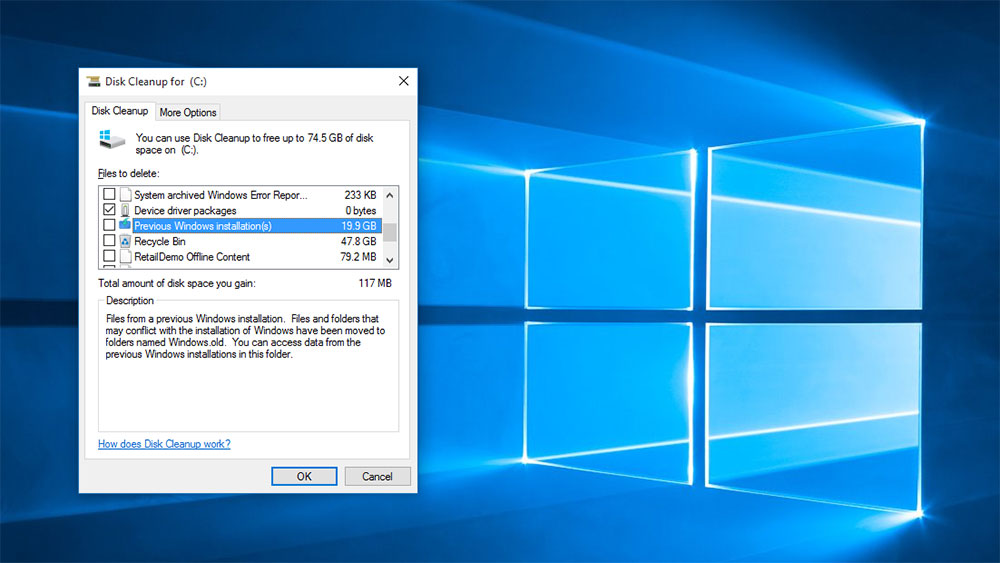Aug 19, 2015 Delete Previous Windows Installation(s). The question was why i dont have the free space what it show me there.And from what i know Windows.old is eliminate when you delete temporally install update(and this i have delete it after i done whit the Previous Windows Installations.). Sep 08, 2015 Laptops How to delete the Windows.old folder from Windows 10. If you upgraded your PC from a previous version of Windows, consider getting rid of this space-hogging folder. Jul 05, 2017 After the 10 days, Windows will delete the files to free up disk space–but you can delete them from here immediately. On Windows 10, installing a big update like the Anniversary Update or November Update is treated basically the same as upgrading to an entirely new version of Windows. Some only appear on previous versions of Windows, like.

Did you upgrade your PC to Windows 10? If so, ever wonder what happened to the previous version of the OS? It probably disappeared into the mists of Windows past, right?
Wrong. Your old OS didn't get erased; rather, it's lingering in a system folder called, aptly enough, Windows.old. And depending on the size of that version, it could be hogging a lot of precious space.
First things first: If you think you might want to downgrade from Windows 10 back to the previous version, don't delete that folder.
More Windows 10 tips
Second, unless you're seriously strapped for space on your hard drive, you don't have to do anything: Windows 10 will automatically delete the Windows.old folder one month after you performed your upgrade.
Manually Delete Previous Windows Installations
If you'd rather not wait -- if you want to reclaim that storage now -- you can delete the folder immediately, though not in the way you might expect. Indeed, if you simply click the folder and then press the Delete key, Windows will tell you you need permission, yada-yada, etc.
Here's the proper way to delete the Windows.old folder:
Step 1: Click in Windows' search field, type Cleanup, then click Disk Cleanup.
Step 2: Click the 'Clean up system files' button.
Step 3: Wait a bit while Windows scans for files, then scroll down the list until you see 'Previous Windows installation(s).'
Step 4: Check the box next to the entry, then make sure there are no other boxes checked (unless you do indeed want to delete those items). Click OK to start the cleanup.
As you can see from my screenshots, Windows 8 was occupying nearly 25GB of space -- a full 10 percent of my solid-state drive. Needless to say, I was glad to be rid of it and get that space back.
Are you hanging on to Windows.old just in case, or do you think you'll send it to the recycle bin right now?
If you have upgraded your Windows 10 to the latest version 1703 which is currently available, and you are very sure that you do not want to rollbackWindows to an earlier installation, then you may run Disk Cleanup Tool to remove previous Windows installations after the Windows Upgrade & free up disk space.
Remove previous Windows installation(s)
After upgrading Windows 10 to a newer version, you can free up several GBs of disk space by using the Remove previous Windows installations option in Disk Cleanup Tool. To do this, type cleanmgr in Start search, right-click on it and select Run as administrator to open the Disk Cleanup Tool in an elevated mode.
Once the tool opens, scroll down till you see Previous Windows installation(s). This will remove the Windows.old folder. Check this option and press on OK.
You will be warned that if you clean up the previous Windows installations or Temporary installation files, you will no longer be able to restore the machine mack to the previous version of Windows.
Click on Yes to proceed.
While there you may also want to delete these upgrade & installation files:
- Windows upgrade logs files: These files contain information that may help you troubleshoot upgrade & installation process. If your process has gone smoothly, you may delete these files.
- Windows ESD installation files: If you do not need to reset or refresh your PC, you may delete these files.
- Temporary Windows installation files: These installation files are used by Windows setup and they can be safely deleted.


Of course, if you do not do this, Windows 10 will still run a scheduled task later on to remove these installation files.
Previous Windows Installations Delete Video
Related Posts: